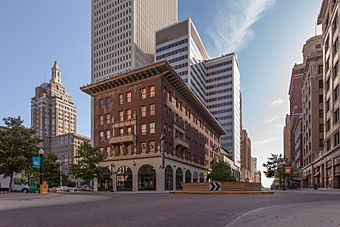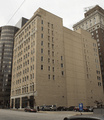Oil Capital Historic District (Tulsa, Oklahoma) facts for kids
The Oil Capital Historic District (OCHD) is a special area in downtown Tulsa, Oklahoma. It celebrates Tulsa's amazing success in the oil business during the early 1900s. Back then, Tulsa was famous as "The Oil Capital of the World." This historic district is located between 3rd Street and 7th Street (north to south), and Cincinnati Avenue and Cheyenne Avenue (east to west).
In the early 20th century, Oklahoma became a huge producer of oil and gas. Many important energy companies set up their main offices or big regional offices in Downtown Tulsa. They often built impressive buildings to show off their success. Other businesses like banks, insurance companies, and hotels quickly followed. However, in the late 1960s and early 1970s, the oil business in the U.S. started to slow down. Companies began to move their offices to other cities. Many of these grand office buildings became empty. Some were changed for new uses, but others were torn down to make way for parking lots or highways. People in Tulsa worried about losing these important historic buildings. They started working to find new ways to use them. Creating the Oil Capital Historic District helped protect these buildings and slow down their loss.
Contents
What Makes a Building Historic?
To be part of the Oil Capital Historic District, buildings had to meet certain rules. They were put into two groups: "Contributing" or "non-contributing."
Buildings that were "Contributing" had to:
- Be built between 1910 and 1967.
- Have been part of the oil business in some way during that time.
- Still look mostly the same as they did historically, without too many changes.
The district has 72 historic "resources." These include 69 buildings, 2 sites, and one object. Out of these, 40 are "contributing" buildings. This means they are important to the district's history. There are also 18 "non-contributing" buildings and 14 that were already listed on the National Register of Historic Places.
Many different building styles can be seen in the district. These include Art Deco, Beaux Arts, Classical Revival, Commercial Style, Greek Revival, Italianate, and Modern Movement. Some buildings don't fit into any single style.
When the Oil Business Slowed Down
Tulsa's importance in the oil industry changed as the United States started to buy more oil from other countries. This oil was often cheaper. Big international oil companies made their Tulsa offices smaller or closed them. They moved to cities closer to the coasts. This happened even more after countries started controlling their own oil resources. The Arab Oil Embargo sped up this change.
The International Petroleum Exposition was a big oil show in Tulsa. In 1966, it had a record number of visitors. But its importance faded, and it happened less often. It was finally canceled after the 1979 show.
Buildings That Were Lost
Sadly, some important buildings in or near the Oil Capital Historic District were torn down. This happened during the decline of the oil business and before the district was created. Here are a few examples:
- The Bethlehem Steel Building (torn down in 1970).
- The Bliss Hotel (built in 1929, torn down in 1973).
- The Hunt Building, also known as the Brown-Dunkin Department Store (torn down in 1970).
- The Medical Arts Building (torn down in 1970).
- The Hotel Tulsa (torn down in 1972).
- The Skelly Building, an office for Skelly Oil companies (torn down).
- The Orpheum Theater (opened in 1917, torn down in 1970). It was replaced by the Tulsa Building & Loan Building.
Historic Buildings Today
Many of the district's historic buildings are still standing. Some have found new life and uses.
First Place Tower
This building was finished in 1973. It used to house the First National Bank of Tulsa and later a Citicorp branch. Citicorp moved out in 2012. In 2014, ONE Gas, Inc. planned to move its main office into this building.
Sinclair Building
The Sinclair Building faced some financial problems. A judge ruled that the City of Tulsa could take over the building. This was because the owner owed a lot of money in taxes and fees. The building could have been sold at an auction.
Tulsa Club Building
The Tulsa Club was started in 1925. It was a social club for rich business people. The 11-story building was built in 1927. It was designed by a famous architect named Bruce Goff. The Tulsa Chamber of Commerce owned part of the building, and the club owned the rest. The club used the top floors and a roof garden. The club left the building in 1994.
After that, the building was bought by an investor. But it was left empty and started to fall apart. People without homes sometimes stayed there. Several fires were even set on purpose inside. The city tried for years to get the owner to fix the problems.
In 2013, Bruce Garrett bought the building for $400,000. He planned to fix it up and keep its old design. Vandals had stolen door knobs and light fixtures. They also covered the walls with graffiti. Fires caused a lot of damage, especially a big fire in the ballroom in 2010.
Even though many developers gave up, a Tulsa construction company called the Ross Group bought the building in 2015 for $1.5 million. They worked with Promise Hotels to restore it. They thought it would cost $24 million, but it ended up being about $36 million. The hotel reopened in mid-2019. The CEO of Promise Hotels said it was "the most expensive hotel in Tulsa, if not in Oklahoma."
633 South Boston Building
This building was designed to be the Tulsa office for the Ponca City Savings and Loan Company. It has been empty for many years. The Tulsa Foundation for Architecture wanted to buy it. They hoped to create a museum of building plans and drawings. But they couldn't raise enough money, so the idea was dropped.
8 East 3rd Street Building
This 10-story building has had a few names, including the Parker Building. It was built in 1929 for the Parker Drilling Company. The company moved to Houston in 2001. The building was empty until Parker Drilling Company got it back in 2012. Then, they sold it to the Anish Hotel Group. This group announced plans to turn the building into a hotel. It is now called the 8 East 3rd Street Building.
As of 2014, the hotel project was on hold. There were many new hotel projects planned for Downtown Tulsa. People wondered if there would be enough guests for all of them. The Anish Hotel Group also thought about turning the building into apartments or offices instead.
Palace Building
This building is also known as the Excaliber Building. It was reportedly owned by the Tulsa World newspaper in 2012. It had been empty for several years, except for an Arby's restaurant on the ground floor. There were rumors that the building would be torn down, but the newspaper denied this.
Petroleum Club Building
The Petroleum Club Building got its name from a private club. This club moved into the top three floors when the building was built in 1963. The building is 196 feet (60 m) tall and has 14 stories. It has 118,000 square feet (10,962 m2) of space. In 1994, a big fire badly damaged the top two stories. This forced the club to close for a while. The club reopened but closed permanently in July 2011. The decline of the oil business in Tulsa meant fewer members and big financial losses.
A company called Consumer Affairs has since remodeled the damaged top floors. They have moved some of their main office staff into the new space. Consumer Affairs is a web-based group that helps consumers. They moved to Tulsa in 2010.
Images for kids
Street views
Contributing buildings
Non-contributing buildings
More Information
National Register of Historic Places Registration Form (This is a detailed document about the district.)

























